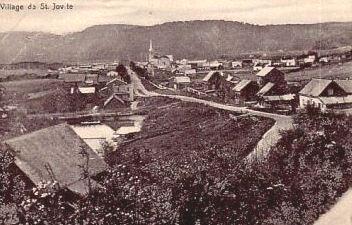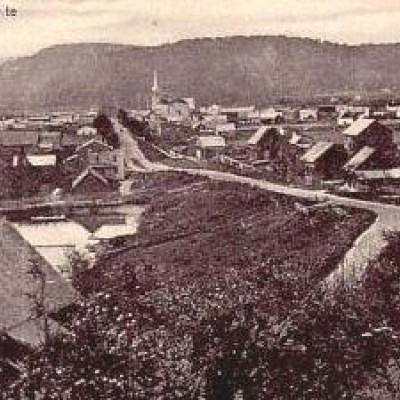--March 13, 2019.
 1. Why was the area in which Curé Samuel Ouimet built the Saint-Jovite mission in 1879 known as “Grand-Brûlé” (big burn)?
1. Why was the area in which Curé Samuel Ouimet built the Saint-Jovite mission in 1879 known as “Grand-Brûlé” (big burn)?
a. There had been a forest fire in the township in 1870
b. It was named in honour of Étienne-Brûlé
c. In 1877, a local logging yard caught fire and the flames reached up to 20 metres high
d. The area was named after the intention of the mission: to incinerate satanic spirits
2. Which geographic feature(s) surround(s) the territory of the Ville de Mont-Tremblant?
a. The corridor of the Rouge River
b. The corridor of the Diable River
c. The visual basin of Lac Tremblant
d. All of the above
e. a and c only
3. What percentage of the Ville de Mont-Tremblant's territory is covered by the 5147-acre fresh water reserves of Mont-Tremblant Park?
a. 19 percent
b. 30 percent
c. 8 percent
d. 4 percent
4. Which industry established its headquarters in the late 19th century in the Saint-Jovite Station district, now known as Beattie-Des-Pins Sector?
a. Saw mill
b. Paper
c. Hydroelectricity
d. Fur trading
5. What was the name of the train that would arrive, packed full of skiers, in Saint-Jovite beginning in 1892?
a. The P’tit Train du Nord
b. The Saint-Laurent
c. The Mont-Tremblant Express
d. The Service des Laurentides
6. Based on which regional style of Québécois architecture was the Mont-Tremblant Lodge built in 1939?
a. Saguenay
b. Beauce
c. Laval
d. Île d’Orléans
7. To which early settler activity does the street “allée des Abattis” make reference?
a. The clearing of lands and the burning of the debris
b. The hunting of wild turkey and the feasts that followed
c. The logging of hardwood and construction of churches
d. The construction of the railway that brought tourism to the region
8. What does the street “chemin de l’Albatross” or Albatross Road refer to?
a. The large population of albatross that would fish in nearby lakes
b. Hitting three shots under par at the nearby golf course
c. A reference to a sailing metaphor for bad luck
d. A pass time of many Jovitiens was to hunt for albatross
9. What event in the year 1920 caused a temporary closure of the Ruisseau Clair sawmill?
a. A fire destroyed the facilities
b. The man-made dam across the Ruisseau Clair’s waterfall gave out
c. Beavers built a dam upriver of the mill slowing the water flow to the mill
d. There was a regional recession that put several logging companies out of business
10. Why did the early Saint-Jovite Parish have to unite with neighbouring Grandison Township in the late 1870s to become a municipality?
a. A civic parish needed a minimum population of 300 and this parish fell short
b. The parish had not yet built its own church and needed one to be recognized officially
c. An official parish needed a water delivery system for its inhabitants and Grandison already had one it could divert
d. All of the above
11. Where were young boys housed and schooled in the parish after their numbers outgrew the local range school in the late 1880s?
a. The nearby monastery
b. The town hall
c. The boarding school in Grandison
d. They were homeschooled
12. What made preliminary electricity to the village of Saint-Jovite unreliable in 1917?
a. It was produced mainly by the adapted sawmill on the Ruisseau Clair
b. Gatineau Power had trouble providing stable electricity to such a remote location
c. The city council could not agree on how to best supply power to the new municipality
d. The power lines were not strong enough to withstand ice and wind storms
13. What tool did volunteer firefighters in Saint-Jovite acquire in 1925 that allowed them to fight fires better?
a. Fire engine
b. Fire hydrants
c. 50-metre leather fire hoses
d. Portable fire pumps
14. How did the Municipality of Saint-Jovite attempt to help its inhabitants during the Great Depression?
a. Financing work for the unemployed
b. Bolstering public hygiene (water, hospitals, etc.)
c. Ensuring the wellbeing of the mentally unstable
d. All of the above
e. a and b only
15. How did Mont Tremblant get its name?
a. The summit is so cold that it makes skiers tremble
b. A fearsome manitou (great spirit) causes the mountain to shake when its peace is disturbed
c. The mountain lies along a fault line that at one time experienced several earthquakes
d. All of the above
16. Up until the 1930s, tourists could be arrested and fined for what seemingly harmless offense in Saint-Jovite?
a. Running along the train tracks
b. Wearing shorts and sleeveless shirts
c. Walking for too long behind a group of nuns
d. Bringing their skis into a hotel
17. How were old graves dealt with when the parish cemetery moved in 1893?
a. They were dug up and bones were put into bags that were brought to new graves
b. They were left in the old cemetery to be overgrown by vegetation
c. New gravestones were made for the deceased in the new cemetery but their remains were not transferred due to the belief that this would disturb the dead
d. Depending on the deceased family’s ability to pay the costs, remains would either be transferred or left in the old cemetery
18. Why was the planned school for boys not built in 1893 on the site of the old cemetery?
a. The land was believed to be haunted by disturbed souls
b. While digging a sewer there for the new school, bones were found
c. Parishioners were angry that digging would be conducted on a previously sacred site
d. All of the above
e. b and c only
19. Why did farmers in Saint-Jovite choose to sell their products to their neighbours at very low prices instead of taking them by train to Montreal?
a. The train was too expensive
b. Their produce frequently arrived damaged or stale
c. The train had a tendency to break down in the winter
d. All of the above
e. a and b only
20. How did the Saint-Jovite Cooperative help farmers in the region?
a. Cream was picked up by truck from farmers in the area
b. Animals were picked up for slaughter and transported to Montreal by truck
c. Farm products could more easily be sold at home
d. All of the above
e. b and c only
21. Why was the train an attractive development for Saint-Jovite wives in 1893?
a. They could visit their families in Sainte-Agathe or Sainte-Thérèse
b. They would regularly receive mail and goods by train
c. They and their children could go to a hospital if they fell ill
d. It allowed them to transport sawn timber into the U.S.
e. All of the above
f. a, b and c only
22. What development in 1939 attracted wealthy Americans to the Saint-Jovite area?
a. The opening of a new highway
b. The opening of the Mont Tremblant Lodge
c. The opening of the first ski lift
d. Advertisement of maple sugar festivals
23. Which feature(s) of Saint-Jovite celebrate(s) the legacy of the P’tit Train du Nord that brought skiers to the hill in droves until the mid 1950s?
a. A railway museum with one of the line’s old locomotives
b. A park along the old railway line
c. A statue in the town square of skiers dismounting the train
d. All of the above
24. Which Indigenous people considered Mont-Tremblant a sacred place?
a. Huron
b. Mohawk
c. Weskarini
d. Cree
25. By what name(s) did these Indigenous people call the mountain?
a. Migizi Kiishkaabikaan (Bird Rock)
b. Manitonga Soutana (The mountain of the spirits)
c. Manitou Ewitchi Saga (The mountain of the great god)
d. All of the above
e. b and c only
*Duncan Crabtree, a History student at Bishop's University in Sherbrooke, interned with QAHN in 2019.
